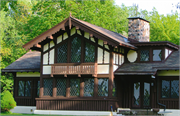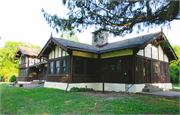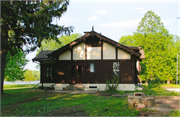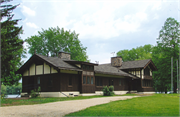Property Record
1000 US HIGHWAY 14/61
Architecture and History Inventory
| Historic Name: | Dr. Adolf and Helga Gundersen Estate |
|---|---|
| Other Name: | |
| Contributing: | |
| Reference Number: | 33544 |
| Location (Address): | 1000 US HIGHWAY 14/61 |
|---|---|
| County: | La Crosse |
| City: | La Crosse |
| Township/Village: | |
| Unincorporated Community: | |
| Town: | |
| Range: | |
| Direction: | |
| Section: | |
| Quarter Section: | |
| Quarter/Quarter Section: |
| Year Built: | 1918 |
|---|---|
| Additions: | |
| Survey Date: | 1996 |
| Historic Use: | house |
| Architectural Style: | Rustic Style |
| Structural System: | |
| Wall Material: | Log |
| Architect: | Bentley and Merman; Peter Nelson and Son-builder |
| Other Buildings On Site: | |
| Demolished?: | No |
| Demolished Date: |
| National/State Register Listing Name: | Dr Adolf and Helga Gundersen Cottage |
|---|---|
| National Register Listing Date: | 1/4/2018 |
| State Register Listing Date: | 8/18/2017 |
| National Register Multiple Property Name: |
| Additional Information: | A 'site file' exists for this property. It contains additional information such as correspondence, newspaper clippings, or historical information. It is a public record and may be viewed in person at the State Historical Society, Division of Historic Preservation. Gable roofed two story stucco extension projecting from the main gable roofed log structure forming the central axis of the house; half timber articulation on the stuccoed front gable two story wall dormer; large chimney of rubble stone; logs used in vertical position for the main structure; faces carved on the ends of the interior living room beams by Rudolf Blotter. Diamond paned leafed glass wndows. Enclosed porch on east side. Exhibiting the log construction and the open beam interior design of the Scandinavian tradition, the Gundersen Summer Cottage constructed in 1918 is a significant unusual example of the work of the local architectural firm of Otto Merman and Percy Bentley. Adolph Gunderson was a permanent Norwegian trained doctor who came to La Crosse to work with the Lutheran Hostpial. Gunderson established the Gunderson Clinic. On a secluded estate overlooking the Mississippi River, Bentley and Merman created what is arguably their masterwork: the Gundersen Cottage. Its design reflects the spirit of the Arts and Crafts movement, laced with a strong Scandinavian flavor, rather than the Prairie style for which they are better known. To capitalize on the scenic setting, the architects oriented the house’s single-story, side-gabled long axis parallel to the river. They ran a ribbon of windows the entire length of the north facade, allowing for views of the water. Two cross-gabled wings--a one-story dining room at the house’s western end, and a larger two-story living room near the eastern end--intercept the long axis and jut toward the river. A shed-roofed wall dormer, sheltering the kitchen, emerges through the main roof near the house’s southwest corner. Bentley and Merman acknowledged the Gundersens’ ethnic roots by giving the exterior Nordic details. Vertical logs in the lower walls give way to decorative half-timbering (executed with alternating spindles and flat posts) in the gable ends and the second story of the living room. Large brackets support the gables’ overhanging eaves, and scalloped bargeboards converge at posts with pendants and finials. The casement windows are leaded, with diamond panes. Even the tiniest details, such as dragon-headed downspouts on either side of the entry, and a plank door with hand-wrought hardware, reflect the Nordic theme. But the Scandinavian theme reaches its fullest development inside. Here, too, we see the expression of the Arts and Crafts aesthetic, which celebrated natural materials and labor-intensive hand-craftsmanship. Unpainted vertical-log walls and wooden-plank ceilings suggest rusticity. Under the living room’s cathedral ceiling, a balcony with a pierced wooden railing meanders around a massive cobblestone fireplace with a tapered chimney breast. Heavy beams support the balcony, and nine whimsical human heads--created by Rudolph Blatter, a Swiss woodcarver working for La Crosse’s Hackner Altar Company--cap the beam ends. Between beams, the molding is stenciled in a pattern suggesting dragons and intertwining vines. The stenciling on the ceiling beams resembles snakes and chains. The dining room, no less impressive, has a frieze stenciled with dragons and gnomes running around the upper walls. Another cobblestone fireplace, this one bearing a Norwegian inscription, dominates the room. The large window sashes slide ingeniously into the lower walls, turning the dining room into an open-air porch facing the river. Adolf and Helga Gundersen immigrated from Norway to La Crosse in the 1890s and built this summer residence in 1918. The Gundersens always maintained strong ties to Norway; Adolf, a respected surgeon, was even knighted by King Haakon VII for his efforts to foster close relations between American and Norwegian medical circles. |
|---|---|
| Bibliographic References: | A. La Crosse (WI) Tribune 30 September 1979. B. Sigrud and Avery Gunderson, interview with Joan Rausch, summer 1977. C. File Ps 262, Commission List, Peter Nelson and Co., La Crosse, Wisconsin and ARC Murphy Library, University of Wisconsin-La Crosse. D. Buildings of Wisconsin manuscript. |
| Wisconsin Architecture and History Inventory, State Historic Preservation Office, Wisconsin Historical Society, Madison, Wisconsin |





